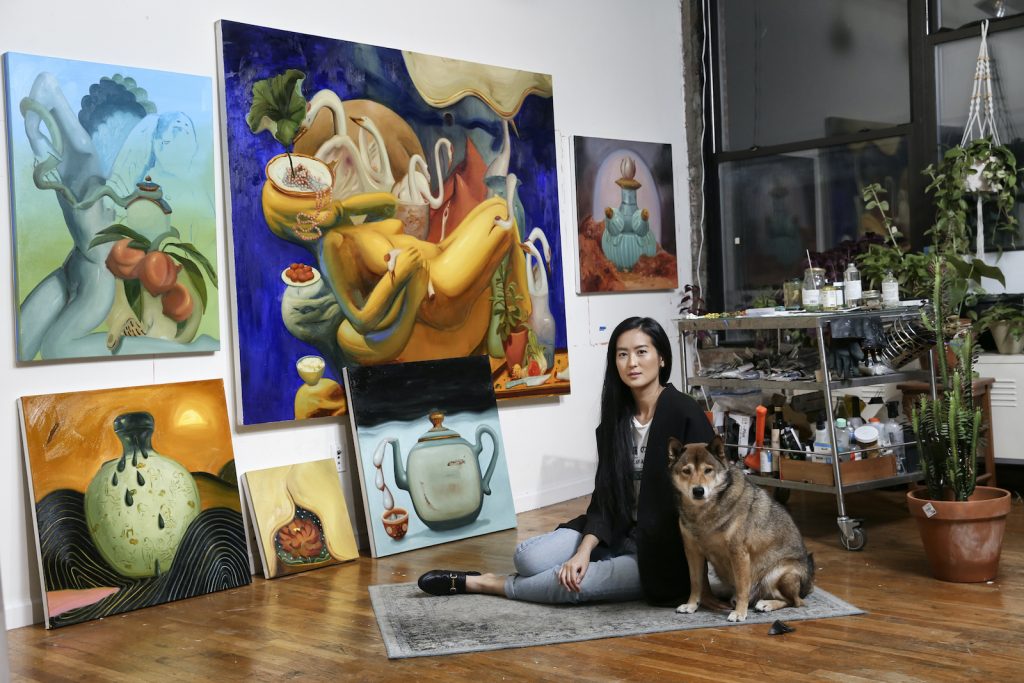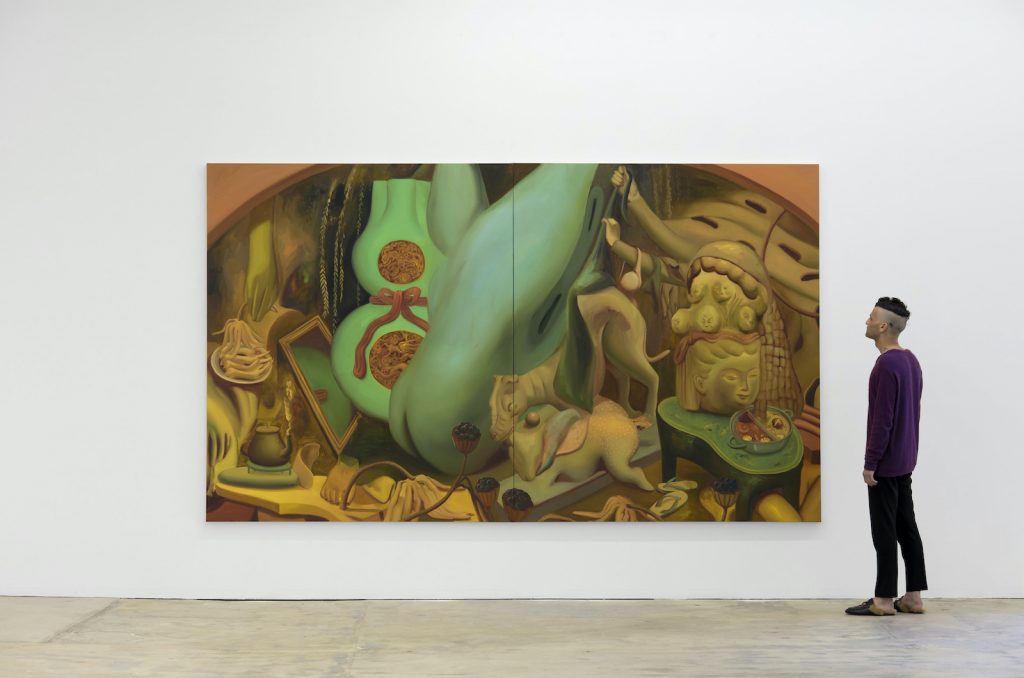People
Five Years Ago, Dominique Fung Was Painting in a Basement Below a Toronto Nail Salon. Now, She’s the Toast of the Art World
Curators, collectors, and dealers are flocking to the New York-based artist's work.

Curators, collectors, and dealers are flocking to the New York-based artist's work.

Brian Boucher

With sold-out exhibitions in New York, Los Angeles, and Shanghai; museum curators buying up her works, which climb into six-figure pricing territory; and enthusiastic coverage from Vice to Juxtapoz to Bomb, Dominique Fung, who turns 34 this year, has established a career that would be the envy of artists decades her senior.
She’s traced a remarkable trajectory for an artist whose first group show was in 2017, and who holds a bachelor’s in applied arts from Ontario’s Sheridan Institute of Technology and Design, not an M.F.A. from a powerhouse program like Yale or RISD.
Born in 1987 in Ottawa and now living in New York, Fung creates paintings with lush surfaces, deep conceptual underpinnings, and compelling personal dimensions. Double Happiness, a painting she showed this summer at her sold-out New York solo show with Jeffrey Deitch, “It’s Not Polite to Stare,” for example, was created amid a wave of attacks against people of Asian descent in the wake of the pandemic. The painting comments, as many of her works do, on the fetishizing of Asian culture and Asian women in particular.

Dominique Fung, Double Happiness (2021). Courtesy of the Artist, Jeffrey Deitch, and Nicodim Gallery.
“This was right in the aftermath of the Atlanta shooting,” Fung said, referring to 21-year-old Robert Aaron Long’s murder of six Asian American women at Atlanta-area spas in March. The killer, who is white, said he needed to eliminate sources of sexual temptation.
“I was processing all the Asian hate crimes, and what I myself was experiencing on the street,” Fung told Artnet News. At one point, she went to a favorite New York Asian restaurant and saw the windows vandalized “with what looked like bullet holes.”
Double Happiness shows two blue-and-white vases in glass cases, backed by figures based on ancient Buddhist sculpture; one of the glass cases bears a bullet hole. The painting is now in the collection of the Institute of Contemporary Art in Miami, whose artistic director, Alex Gartenfeld, described the Buddhist figures as “amazing cartoon-like” forms “that have a spectral presence as witnesses to the crime that has preceded the image.”
“From the institutional perspective, we’re excited to be engaging with a young generation of artists who are dealing with figurative work,” Gartenfeld said. “Our collection is also a dialogue of work of the postwar generation and the most contemporary work of today, and Dominique’s is an excellent example of that, as she is looking to traditional forms.”
Indeed, Fung’s paintings mine Western art history, too, starting with Surrealists like Salvador Dalí and Frida Kahlo, who she discovered as a child, and the Baroque, Dutch, Flemish, and Rococo works she later devoured via textbooks. Those formal influences combine with foundational theoretical texts old and new, including Edward Said’s Orientalism (1978) and Ornamentalism (2018) by Princeton English professor Anne Anlin Cheng. From the latter, Fung took the idea that since people like her have often been treated as objects, why couldn’t the objects she paints also be treated as subjects, with lives of their own?

Dominique Fung, Material Manifestations in the Act of Remembrance (2020). Courtesy of the Artist and Nicodim Gallery.
But it’s not all heavy-duty stuff: she told Juxtapoz that her interest in combining alluring veneers and serious undertones comes from her favorite stand-up comedians, like Ali Wong and Trevor Noah.
Fung has quickly built a following. Mihai Nicodim, who represents the artist, sold everything in “Relics and Remains” at his Los Angeles gallery as well as a presentation of works at ART021 Shanghai, both last year, with her paintings commanding prices ranging from $20,000 to $100,000. “I’m focusing on [selling to] institutions right now,” Nicodim told Artnet News, though he has placed her work with the likes of Hollywood mogul David Hoberman and Felix art fair cofounder Dean Valentine. He’s planning a second L.A. solo show for Fung in early 2022.
So what’s it like to experience such a precipitous climb, from painting in a studio in the basement below a Toronto nail salon (which Fung guesses was probably illegal), to the limelight in New York? “I’m a little overwhelmed,” she said, and quickly added, “Not a little. Very overwhelmed.”
After moving to New York at 29 (“I was still in my twenties, so I thought, ‘Just try!’”), she built her career in the old-fashioned way, going to openings, meeting artists, and showing in artist-run spaces. Social media played its part; she’s racked up almost 24,000 Instagram followers, where she garners likes from other up-and-coming painters her age, such as Sarah Slappey, as well as advisors like Wendy Cromwell, who told Artnet that “I’m always interested in artists who are collapsing past and present, and she instantly caught my eye because she was clearly taking stereotypes and tropes of Asian American culture and turning those ideas on their head, but without rejecting them.”

Dominique Fung, Midnight Catch (2020).
Despite her rapid climb, it’s still just Fung creating the works without assistants: she has controlled everything for so long that she can’t imagine involving anyone else in making the paintings. But she is planning a move from her increasingly cramped studio in Brooklyn’s Bedford-Stuyvesant neighborhood to a larger one in Bushwick, and is looking to hire someone to stretch her canvases.
At the same time, she’s newly branching out into sculpture and installation. “I’ve never thought of myself as purely a painter,” she said. Many of her new works use found birdcages of the type that she knows from Hong Kong marketplaces, in which she places ceramic sculptures. And she’s taking her time with the new medium. “I stared at the birdcages for months,” she said.
Just as the objects she paints take on a life of their own, her thinking about the birds that inhabited those cages flips the script.
“Old folks hang the cages in parks so that the birds can commune with each other,” she said. “And people then sit and have a conversation. I thought that was beautiful and fascinating. We’re all just animals that need a connection.”